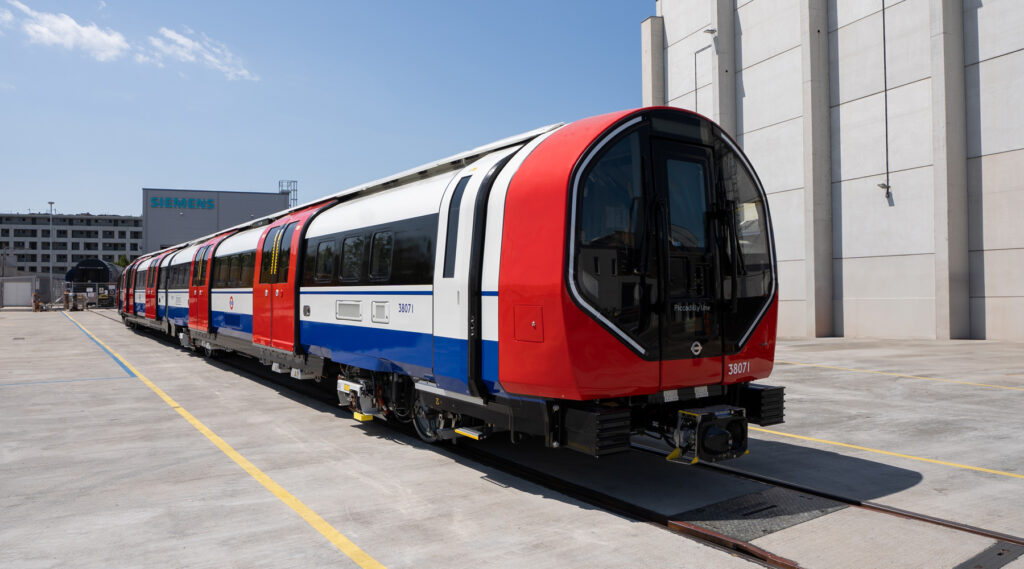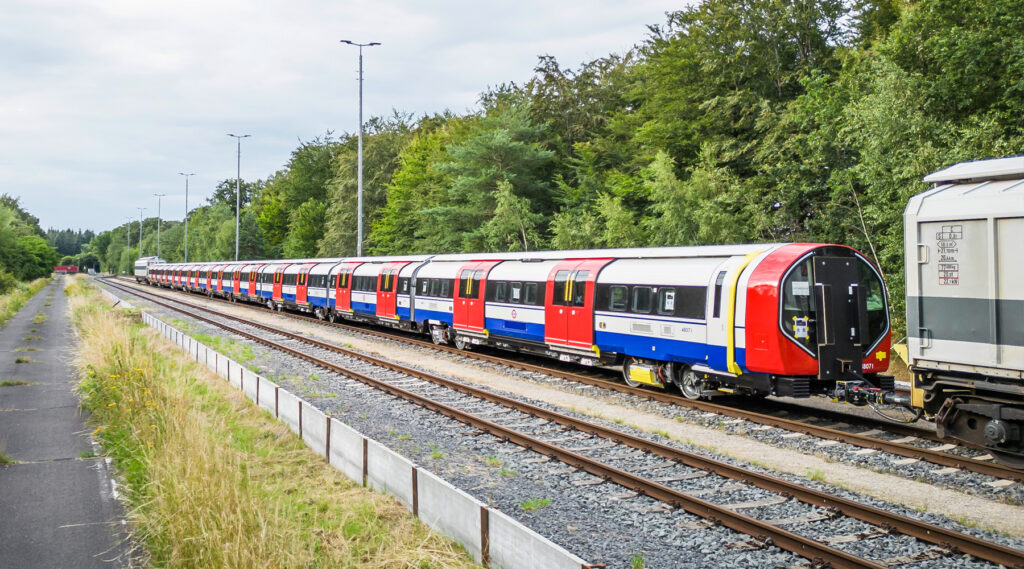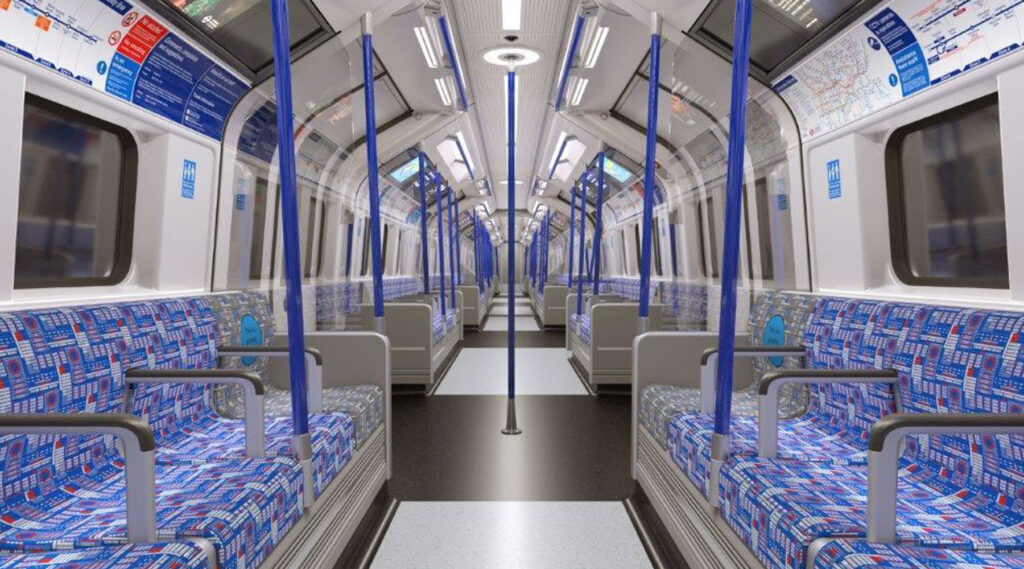The first of the new tube trains being built for the Piccadilly line has arrived at the manufacturer’s testing centre in Wegberg-Wildenrath, Germany after being spotted en route there last week.
The first nine-carriage train came off the Siemens Mobility production line in Vienna at the end of July before being transported to the Test and Validation Centre by rail, sparking a load of trainspotter photos of the unusual sight of a London Underground train in mainland Europe.
Now that it has arrived at the test centre in Germany, the train will be put through rigorous tests including acceleration and braking functionality, noise and vibration trials, as well as testing all the equipment onboard, both hardware and software, and functional tests of the interfaces the train will have with off-train equipment.
This is the type-testing to ensure that the design works as expected. Future trains that are built will still get fault-testing, but won’t need the intensive prototype testing that the first few trains will need to go through.
Although this first train was built at the Vienna factory, about half the trains will be built in the UK, and work to complete Siemens Mobility’s new site in Goole, Yorkshire is near completion. Full production of the new trains in the UK should start next year.
Sambit Banerjee, Managing Director for Rolling Stock and Customer Services for Siemens Mobility UKI, said: “The first new Piccadilly line train is now at our world class testing facility in Germany where it will undergo a period of extensive testing. This is the first stage of testing before London Underground’s newest train reaches the UK for further testing and integration in late 2024. I am incredibly proud to see this first train continue its journey towards enhancing passenger experience and transforming rail travel on the Piccadilly line.”
The new trains are due to start entering passenger service in London from 2025, replacing the existing fleet dating from the 1970s.
Stuart Harvey, TfL’s Chief Capital Officer, said: “We hope to follow the introduction of these new trains to the Piccadilly line by doing the same on the Bakerloo line, replacing the 51-year-old trains that it currently operates, and then by introducing new signalling across the Deep Tube lines to realise the full benefits of the new trains. However, such large-scale investment will not be possible without continued capital investment from the Government from April 2024. We will continue to work with the Government to make the case for long term investment in London to make it an even better, greener, safer and more successful place for everyone.”
The Piccadilly line trains are based on Siemens Mobility’s Inspiro family and will increase capacity by around 10 per cent and are also significantly lighter than existing designs which will mean the trains are more energy efficient as well as providing a smoother ride for passengers. The lighter weight is due to the innovative articulated design which requires fewer bogies (the structure containing the wheels, motors and suspension to support and power the train).
There is also a – currently on hold – plan to upgrade the signalling system on the Piccadilly line, which would increase capacity from 27 to 36 trains per hour.
The new trains also have the theoretical ability to be upgraded at a later date to driverless operation, but that would at a minimum require a huge amount of upgrades to the stations first.










Hopefully a better long term funding agreement can be sorted out, even if we have to wait until just after the next general election for it.
I guess upgrading the signalling system to increase the number of trains per hour is less urgent now the Elizbeth line is running, as passengers to/from Heathrow can use that instead. If spending remains limited I’d prefer to see the new trains rolled out onto the Bakerloo and Central Lines. Being able to walk through carriages will be a great improvement for those lines, in addition to the air conditioning.
I think the only line where driverless trains might be a viable option is the Waterloo & City line. Mainly as that line consists of only two stations, which makes things simpler. Additionally being closed at weekends presumably would make it easier and less disruptive for at least some of the upgrades to be done.
I wonder if Siemens have installed a forth rail on their test track in Germany? I somehow doubt if they have. I ask this question because these trains are eventually destined for the Bakerloo line and LT have a long term plan to extend the Bakerloo Line to Hayes. Reading between the lines of a recent LT press release it seems LT are intent on converting the existing British Rail track from 3rd rail to 4th rail. No doubt at a huge cost and massive disruption to passengers (note how long the much shorter East London line was closed to convert from 4th rail to 3rd rail).
If it is possible design a train to take the current from an overhead wire and third rail, it must surely be much easier for Siemens to design a train that can operate on both forth rail and third rail tracks ?
And potentially this could give LT huge savings by converting all surface LT tracks to third rail ?
Siemens Mobility has built a tube-compatible track for the testing – and while TfL has an intention to extend the Bakerloo line to Lewisham, any further extension is highly speculative at the moment, and decades away at best.
“And potentially this could give LT huge savings by converting all surface LT tracks to third rail ?”
I doubt the cost benefit analysis would show it would be worth doing.
Note the works to the East London line were a lot more expansive than just changes to the track
Converting the East London Line from 4th to 3rd rail line was the easy part. Having walked Brunel’s tunnel after the works were completed, this was a major refurbishment of the oldest tunnel under the Thames with significant works including relining much of the tunnel.
Extending Bakerloo line to Lewisham is a good idea, but to Hayes: really bad in my view.
To cater for the lower carriages either the platforms of all 9 stations will have to be lowered or 8 miles of line from Ladywell to Hayes will have to be lifted. Won’t this shut the entire line for several months?
Also, the 10-coach Southeastern trains have 3 to 4 times the seating capacity of Bakerloo trains so their 4 trains per hour are equivalent to at least 12 Bakerloo per hour, even more if 12-coach trains are run and that is possible today.
Southeastern run at up to 60mph down the Hayes line whereas Bakerloo stock is limited to 45mph.
There are much better things to do with the Hayes line, if you must. The DLR was considered, so I heard, another was an East London crossrail from Gatwick to Stanstead via Lewisham.
Why dont they make the seats pure plastic rather than that fabric thing? It collects filth like a magnet and impossible to clean unless they wash them every night. You can spary antibacterial cleaner to the plastic seats and wipe it clean.
Lord no. Plastic seats are abominable.
Good to see some of the older trains getting replaced. it is however a little frustrating we are coming up with trains with only 2 doors either side on each carriage rather than 3 to speed up boarding and alighting. In Japan some commuter trains have 5 doors either side. It would be great if we could look at changing this at some stage.
Actual distance between doors is not longer than those on Japanese trains. They have five doors per carriage because their carriages are longer!
more doors = fewer seats
fewer seats = more complaints that there aren’t enough seats
Who cares about complaints on the lack of seats anyway?